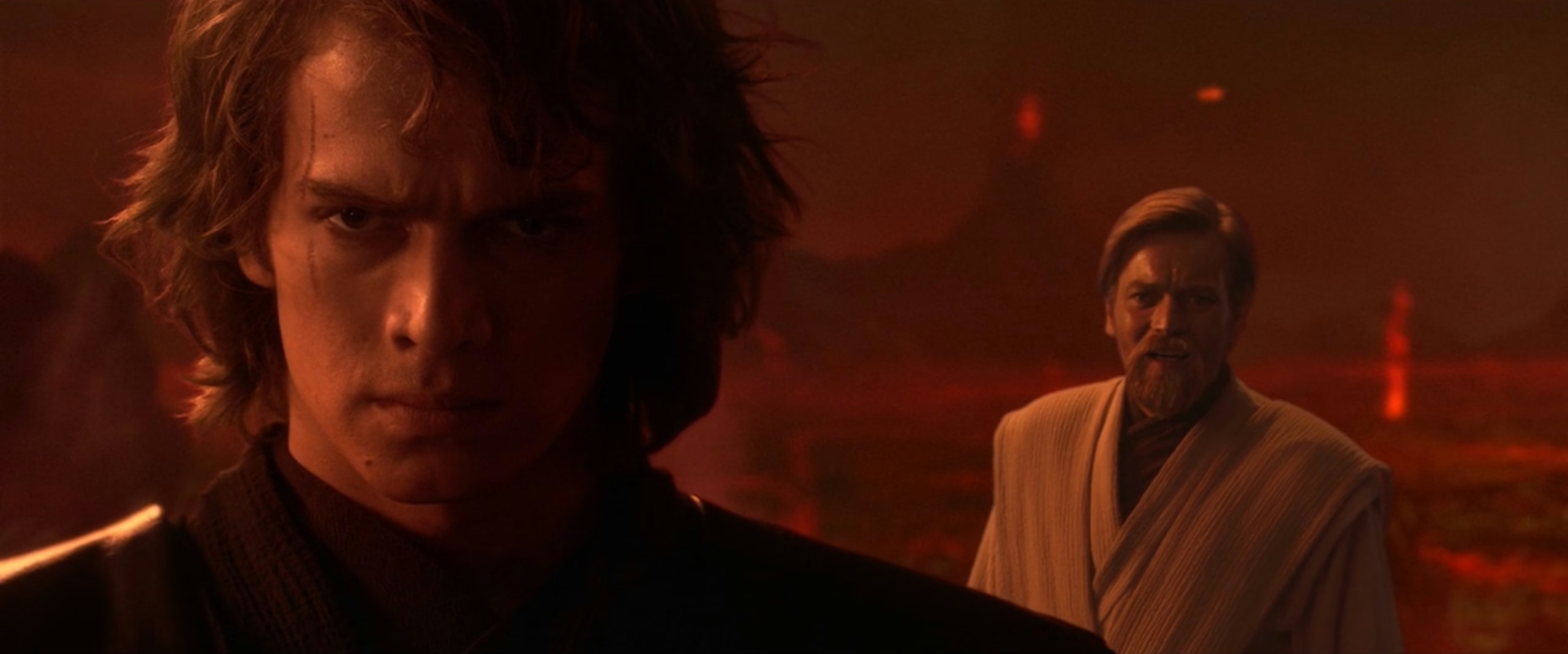George Lucas | 2hr 20min
This review was requested by Matthew, who shared the following thoughts:
“An epic effort in terms of narrative, drama, and yes – filmmaking prowess. Lucas carries over the visual beauty from the previous installments of his cutting-edge trilogy of digital experimentation (it’s the most polished of the bunch too), while leveling up the editing a notch or two. You have the cross-cutting in the finale (aided by John Williams’ all-timer score), the Order 66 montage (lifted from his old friend Coppola), and the structural parallel editing between the intimate character-driven drama and the mirroring political descent of the Republic that manufactures a far more emotional response to the (what’s typically considered bland or unemotional) failing bureaucracy – quite fascinating conceptually, and certainly an emotionally effective achievement!”

For all the flaws that plague the Star Wars prequels – and there are undeniably many which continue through to Episode III – very few can detract from the operatic descent into darkness that Revenge of the Sith ushers in. George Lucas is walking a tighter rope than ever, binding together the parallel downfalls of Anakin Skywalker and the Galactic Republic, and driving both towards the epic convergence of trilogies. As such, the long-promised transformation of tormented hero into formidable Sith Lord makes for a devastatingly epic conclusion, embracing the melodrama, myth, and political allegory of the entire saga to craft its most tragic chapter.
Of course, it is Chancellor Palpatine’s political cunning that underpins it all, pulling the strings of allies and enemies alike in a war that he is engineering from both sides. His kidnapping by General Grievous’ Separatist forces is evidently nothing more than a calculated ploy, designed to lure Anakin into direct conflict with Count Dooku and ensnare him in a moral trap that inevitably leads to the cold-blooded execution of the Sith Lord. Compromises like these aren’t just pragmatic, Palpatine duplicitously insists – they are necessary evils to shield the innocent from danger. Where the Jedi Council withholds their trust from Anakin, Palpatine perfectly understands how his insecurities may be exploited, offering personal validation and the promise of life-saving abilities which the light side of the Force cannot guarantee.
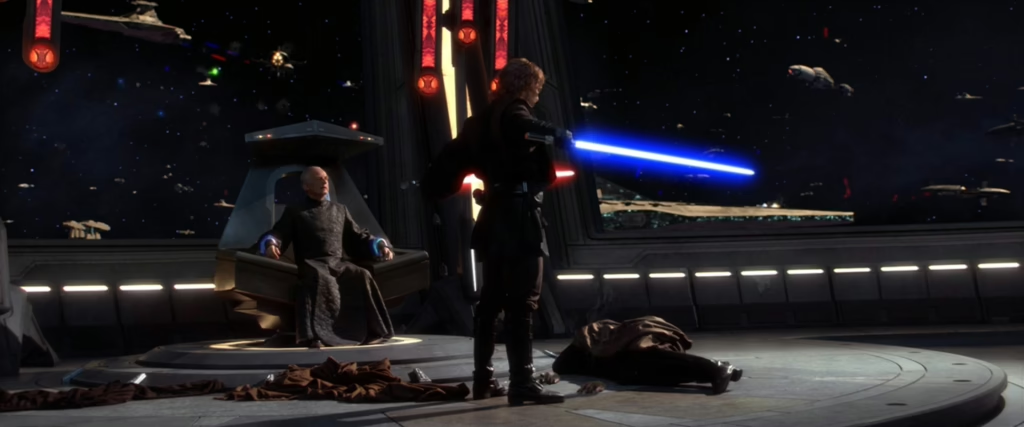

With foreboding dreams of Padmé passing away in childbirth shortly after her pregnancy announcement, Anakin is particularly vulnerable to the ancient lure of the dark side, which sees love as an easily exploitable gateway to fear, jealousy, and hatred. Their romantic dialogue remains unconvincingly flat, yet against the blue day-for-night wash and urban shimmer of Coruscant’s city lights, Lucas leans into sombre atmosphere over clean articulation. Darkness continues to visually consume Anakin within Yoda’s dim sanctum as well, moodily accentuating his eyes through strips of light, while the oppressive red hues of Palpatine’s office envelope him in a theatre of temptation and control. Right from the opening shot’s simulated long take navigating starships and explosions, it is evident that Revenge of the Sith is the most formally assured Star Wars film since The Empire Strikes Back, and the sharpest, boldest entry in the prequel trilogy.

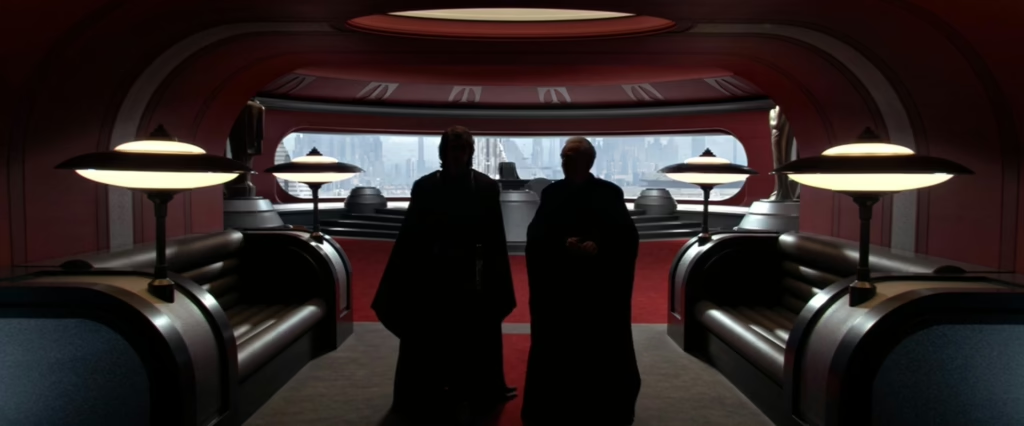
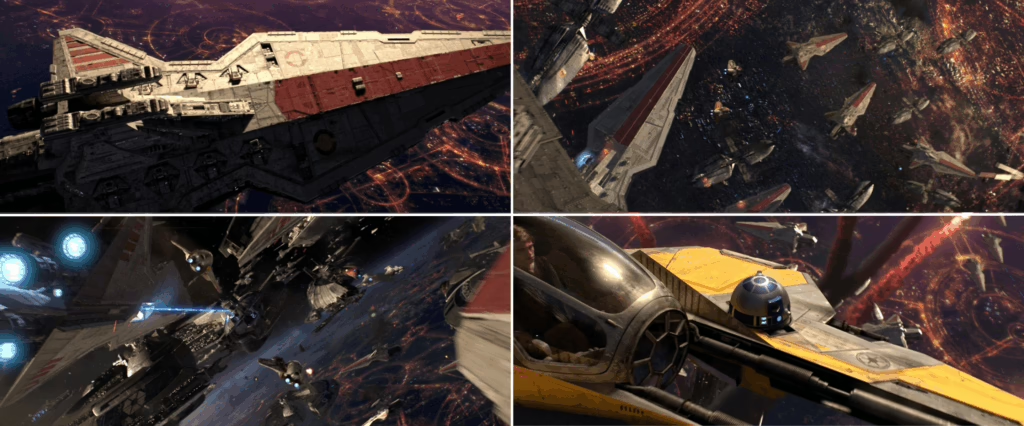
Especially when Obi-Wan Kenobi is sent to deal directly with General Grievous on the remote planet Utapau, Lucas’ filmmaking begins to tighten, frequently intercutting his mission with Anakin’s internal struggle back on Coruscant. Where one narrative strand establishes Obi-Wan as a paragon of Jedi courage and discipline, fighting a four-armed, lightsaber-wielding cyborg, the other concurrently observes a far more conflicted Jedi caught in a crisis of identity. Palpatine appears to be the only authority figure putting his faith in Anakin, appointing him to the Jedi Council as his representative, while fully understanding that this will only sow discord in their ranks. They do not trust Palpatine in the slightest, and given his growing relationship with Anakin, the young Jedi has similarly become a source of concern. Not only does the Council’s refusal to grant him the rank of Jedi Master alienate the frustrated prodigy, but their request for him to spy on the Chancellor further deepens his resentment, bitterly casting him as a pawn in their political machinations.
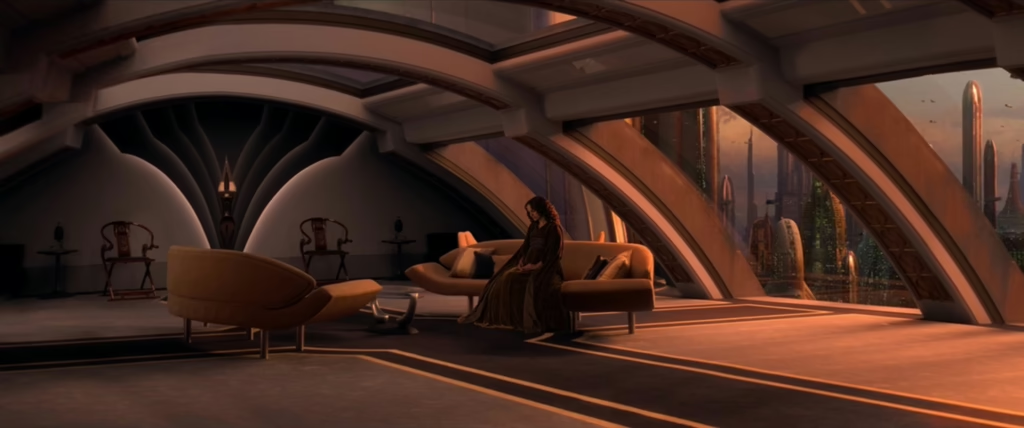
The high angle capturing Anakin sitting alone in the circular Jedi Council Chamber thus makes for a particular compelling composition, hollowing out the once-balanced room and ominously foreshadowing the decimation to come. Though he initially reacts to Palpatine’s unveiled identity as Darth Sidious with indignant fury, the Chancellor’s duel against Mace Windu forces one final moral reckoning, pitting Anakin’s fading loyalty to the Jedi against his overwhelming fear of loss. His impulsive interference is all Palpatine needs to turn the tables on Windu, therefore sealing Anakin’s betrayal of the Jedi and binding him irrevocably to the dark side. In this moment, as he pledges himself to Palpatine’s teachings, Darth Vader is born – and ‘The Imperial March’ menacingly arrives with heavy, thundering dread.


Revenge of the Sith only gains further momentum with Anakin’s spiral into darkness. Symmetrical compositions accompany his embrace of authoritarian power as he marches into the Jedi temple, backed by clone troopers and cloaked in shadow. The time has come for Palpatine’s long game of orchestrated division and misdirection to come to fruition, exacting a coordinated purge with an efficiency so cold, swift, and ruthless, that all enemies to the emerging Galactic Empire are extinguished before they can fight back.
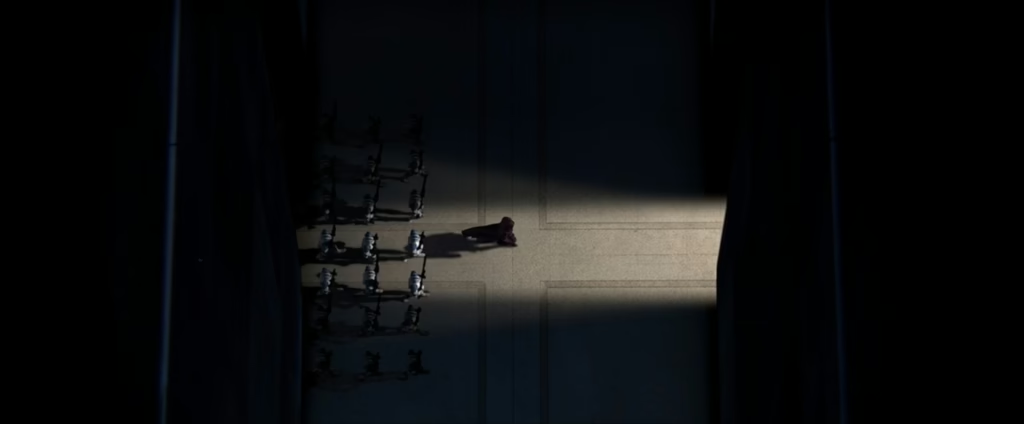
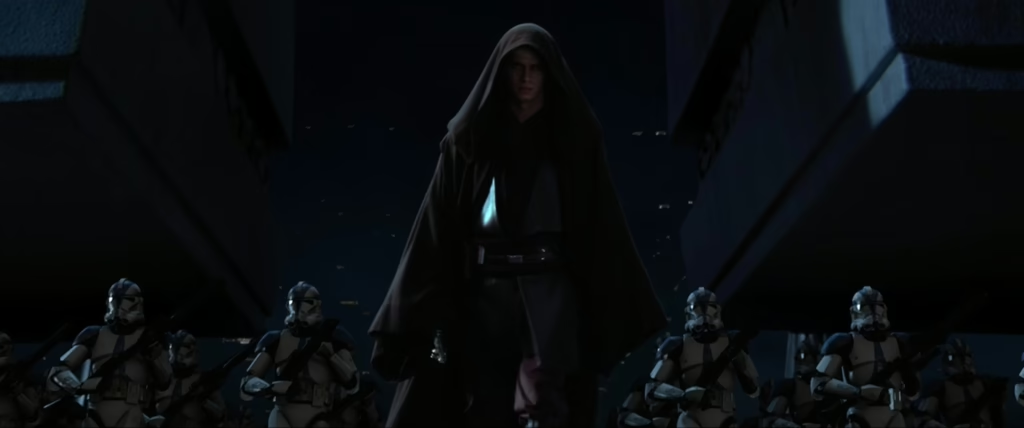
Like sleeper agents awakening after years of obedience, every clone trooper once programmed to fight for the Republic now turns on their Jedi allies, executing Order 66. Lucas efficiently cuts across each planet where this massacre unfolds, and through its brisk but solemn pacing, echoes of The Godfather’s climactic baptism montage are unmistakably evoked. The sheer scale of betrayal is carried through John Williams’ epic, musical eulogy that underscores the sequence, though given the piece’s title ‘Anakin’s Betrayal’, it is clearly mourning more than just the death of the Jedi Order. Indeed, the sight of Anakin preparing to slay the Jedi younglings back on Coruscant may very well be the darkest point in the entire franchise, heralding the rise of a merciless monster.


How quickly Palpatine commands the obedience of the Senate as well, whose “thunderous applause” welcomes the death of liberty and the birth of the Galactic Empire, much to Padmé’s dismay. Physically scarred by his encounter with Windu, he appears much closer to the Emperor from the original trilogy, yet somehow Lucas’ prosthetics now look more like a Halloween mask than a believable visage of corrupted humanity. Although this criticism can largely be applied to his reckless embrace of CGI as well, his digital craftsmanship has at least grown more seamless with each prequel instalment, culminating in a finale that confidently synthesises digital ambition and visual grandeur.
That Lucas’ parallel editing should set the Republic’s dissolution against Anakin’s slaughter of the Separatist leaders only further underscores the double-sided nature of the tragedy at hand, effectively collapsing both sides of the war at once. Even Obi-Wan and Yoda, the only two surviving Jedi, find themselves at a loss over how to move forward – save, perhaps, for a pair of final confrontations with the two rising Sith Lords.
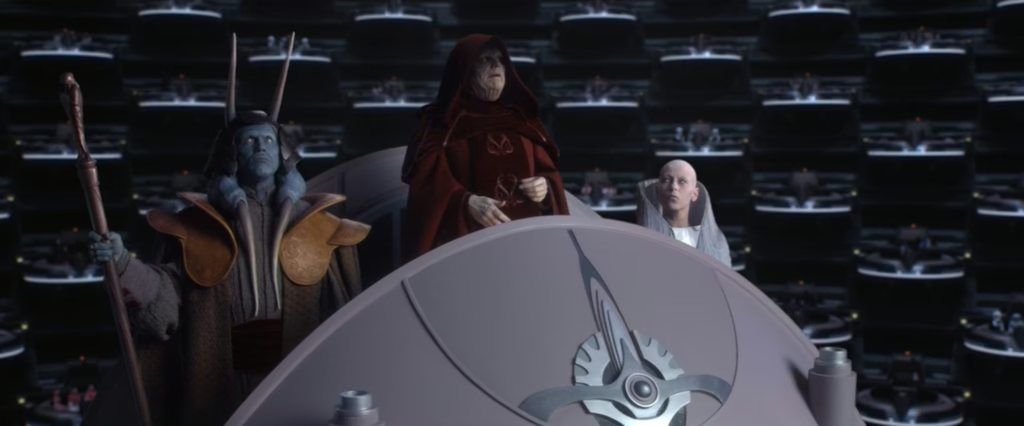

Once again, Lucas’ inspired crosscutting lends enormous weight to these sequences, respectively staging duels between the two most powerful Jedi and the two most powerful Sith. Though one unfolds in the Senate Chamber and the other on the volcanic plains of Mustafar, each mirror the other in intensity and consequence, reinforcing the duality of the Republic’s collapse and the rise of the Empire. The deep focus framing of Anakin’s hateful expression in close-up and Obi-Wan’s melancholic expression in the background further emphasises the distance that has grown between them, making for a particularly poignant parallel to the earlier composition of Anakin and Palpatine’s profiles at the theatre, aligned in eerie harmony.
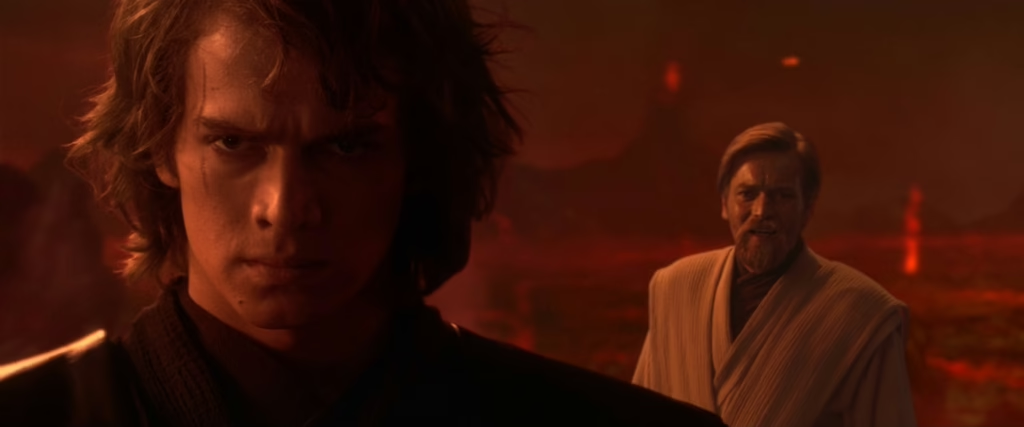
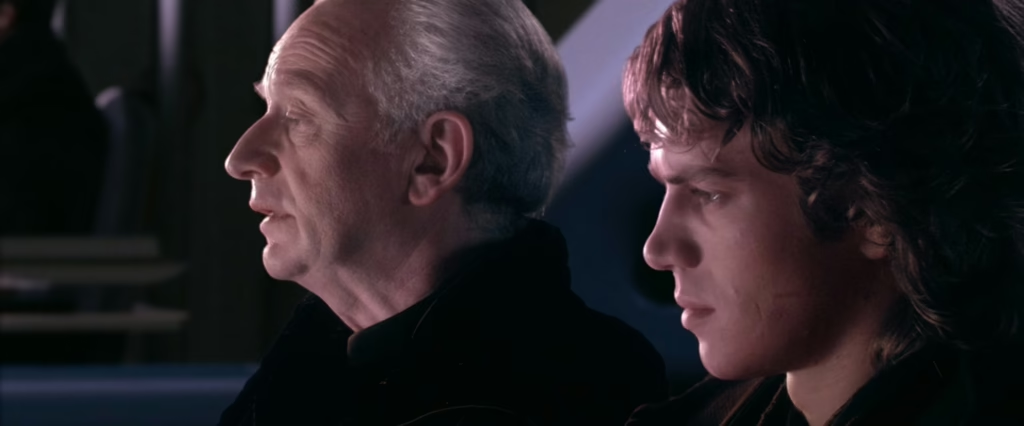
Washed with the red glow of Mustafar’s molten fury, Anakin and Obi-Wan’s duel unmistakably resembles a descent into hell, where flows of spurting lava mirror the emotional volatility of their broken brotherhood. Only their blue lightsabers pierce the oppressive haze, casting flickers of clarity in a chaotic landscape. The digital effects are again a little wobbly here, and Hayden Christensen still struggles to sell his underwritten dialogue, yet Ewan McGregor’s raw anguish as he desperately calls out to his fallen friend demonstrably secures his place as the strongest actor in the prequel trilogy.
“You were the chosen one! It was said that you would destroy the Sith, not join them! Bring balance to the Force, not leave it in darkness!”

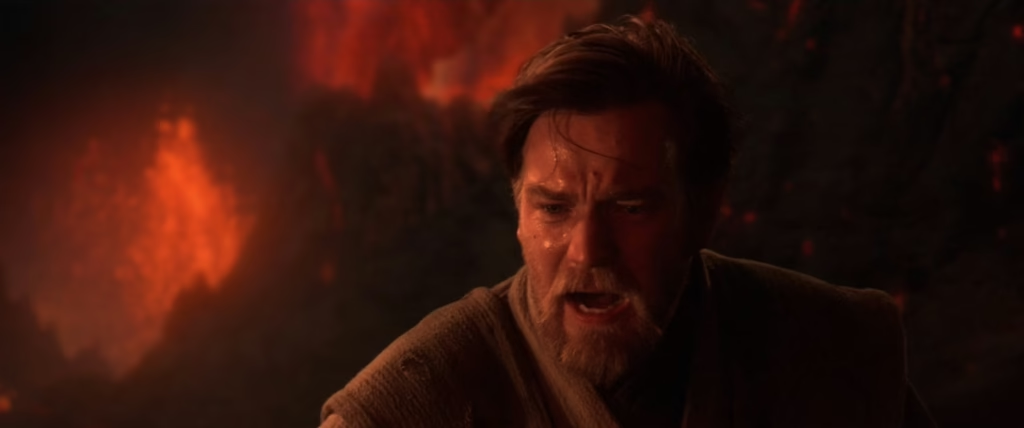
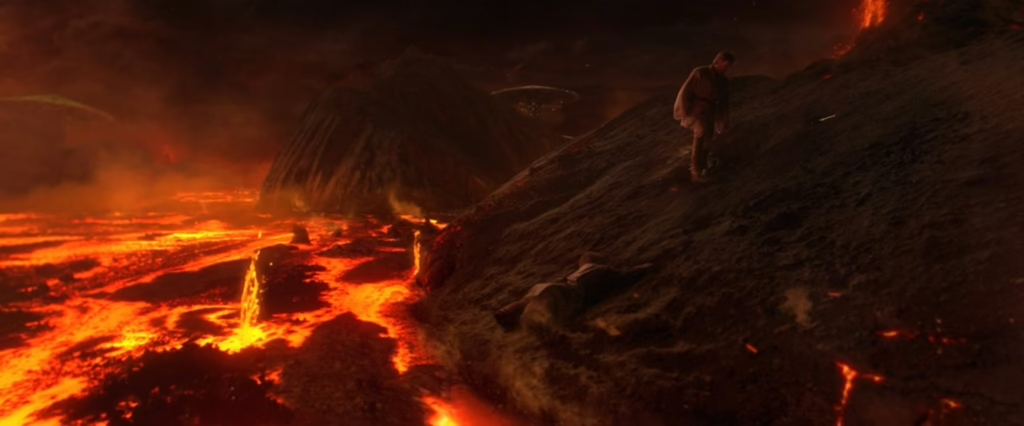
As it is, this nascent incarnation of Darth Vader is no match for Obi-Wan. With a single, devastating strike, he severs Anakin’s limbs, and leaves him to burn in fire and hatred. Palpatine’s rescue of his dying apprentice thus marks the final step in his transformation, forcing him to don a black, mechanical suit and helmet that keeps him clinging to life – but certainly not his humanity. Just as a horrifically maimed Anakin cries out in a dingy operating theatre, so too do we witness Padmé deliver twins in a pure, white light, effectively interweaving the birth of Darth Vader and his twin children through ingenious match cuts. Although Padmé passes away, tragically fulfilling Anakin’s dream, the Force’s balance of light and dark is nevertheless drawn precisely down to the structure of Lucas’ narrative design.

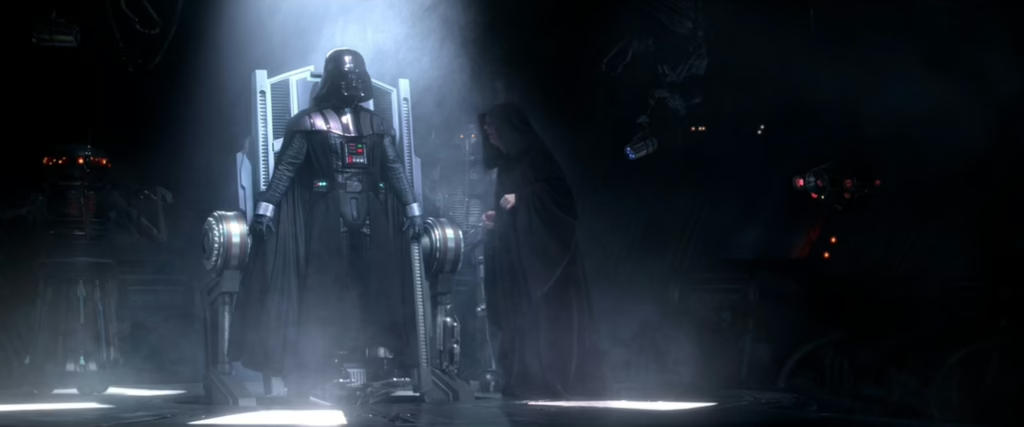
By eloquently setting up Padmé as the uncorrupted voice of the Republic, her funeral accordingly tolls the death knell of democracy as well, while the two last bastions of resistance – Obi-Wan and Yoda – retreat into self-exile. Unlike the endings to the original and sequel trilogies, there is no great victory to celebrate, but rather the mournful scattering of Jedi across the stars. Thankfully eschewing his typically weak dialogue, Lucas’ visual storytelling steps into the spotlight one last time, leaving baby Leia with Senator Organa on Alderaan and Luke under Obi-Wan’s discreet vigilance. As his montage silently glides through each of these settings, so too does Williams’ score weave together echoes of musical motifs belonging to Leia, Luke, Vader, and of course, the main Star Wars theme itself. Against the setting twin suns of Tatooine, Lucas thus ends Revenge of the Sith with a return to the saga’s origins, and finally sets his reverent gaze upon a new, emerging hope on the horizon.


Star Wars: Episode III – Revenge of the Sith (2005) is currently streaming on Disney+, and is available to buy on Apple TV, YouTube, and Amazon Video.
Have a film you’d like me to write about next? Request a review here.

